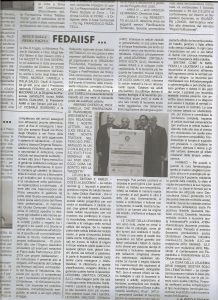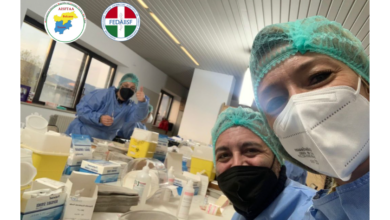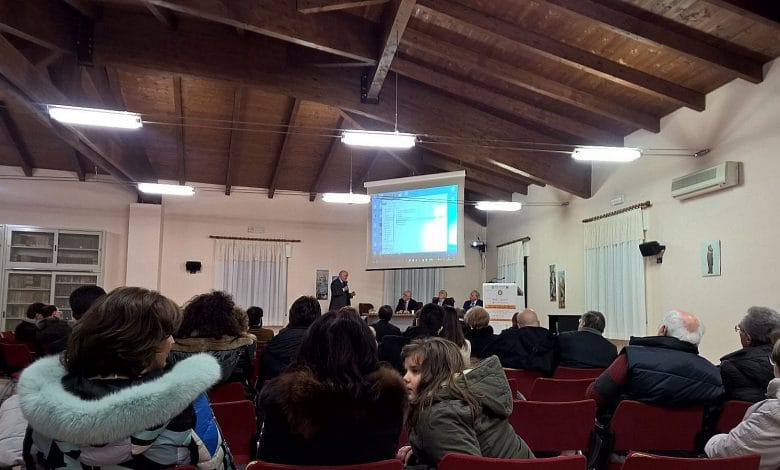
The conference "Modern approach to the diagnosis and treatment of haematological malignancies”, of which we have already published the poster. The event was well attended (about 60 listeners including doctors, ISF and citizens) and represented an important start of collaboration between the Foggia Section of Fedaiisf, the Rotary Club 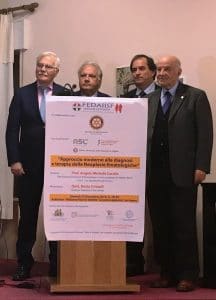 and other associations among which “L'albero della vita onlus” stands out, a support association for patients and the families of cancer patients.
and other associations among which “L'albero della vita onlus” stands out, a support association for patients and the families of cancer patients.
In the photo on the right, from left appear Prof. Angelo Michele Carella, Past-Director of the Hematology Division and bone marrow transplant center of the San Martino Institute of Genoa; the second from the left is Dr. Ciro Acquaviva, President of the Fedaiisf Section – Foggia; the third, the National Federal President, Dr. Antonio Mazzarella, the fourth is Dr. Grazioso Piccaluga, past-President Fedaiisf section of Foggia and past-President Rotary Club San Severo.
The event is part of the promotion of the cultural and professional training of drug sales representatives and the updating of the category in the health sector in order to carry out one's profession in a complete and aware way. 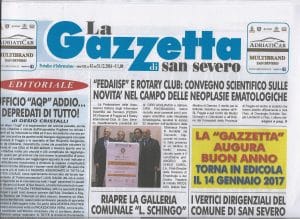
Below is a summary of the event.
Leukemia: causes, symptoms and remedies
Things leukemia?
Normal cells (red blood cells, leukocytes and platelets) originate from immature cells – called Stem Cells, which are found in the bone marrow. When these progenitor cells change for various reasons, the bone marrow creates abnormal white blood cells, i.e. leukemia cells that do not die but proliferate uncontrollably, interfering with the growth and development of normal blood cells.
If the disease starts from the lymphoid cells of the bone marrow, it is called
lymphoid leukemia (also called lymphocytic or lymphoblastic); if, on the other hand, the cell of origin is of the myeloid type (from which red blood cells, white blood cells other than lymphocytes and platelets develop), we speak of leukemia myeloid (also known as myelogenous or myeloblastic). In reference to this classification, four forms of leukemia are generally distinguished:
- chronic lymphocytic leukemia, LLC - in most cases it develops very slowly. Patients diagnosed with this leukemia are usually older. It almost never affects children.
- Chronic myeloid leukemia (CML): affects myeloid cells and generally develops slowly in the first phase, then tends to evolve towards refractory acute leukemia. It mainly affects adults.
- Acute lymphoblastic leukemia (ALL): affects lymphoid cells and develops very rapidly. It is the most common leukemia among children, but it can also affect adults.
- Acute myeloid leukemia (AML or LAM): affects myeloid cells and has a very rapid course. It affects both adults and children. A distinct subtype of this typology is the acute promyelocytic leukemia (m3); it is a rare variety of very aggressive acute leukemia, which causes hypercoagulation of the blood and severe bleeding. It can lead patients to death in a few days and for this reason it must be treated promptly. In fact, if treated quickly and correctly, more than 90% of cases can be cured. Erroneously, we tend to confuse the lymphoma with leukemia: in reality, while leukemia is a tumor that originates from the bone marrow, lymphoma develops in the lymph nodes.
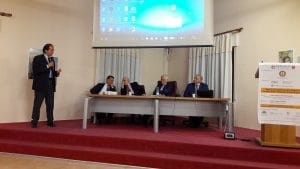 The causes of leukemia are not known, even if by now it is clear that the pathology, like other tumors, can be the final result of a series of events that concern both genetic factors and environmental factors.
The causes of leukemia are not known, even if by now it is clear that the pathology, like other tumors, can be the final result of a series of events that concern both genetic factors and environmental factors.
Risk factors are likely to be different for each type of leukemia and include:
- radiation exposure;
- previous chemo and/or radiotherapy
- atomic explosions (remember the tragic balance between the survivors of the explosions of Hiroshima and Nagasaki, exposed to very high doses of radiation and seriously affected by leukemia);
- x-rays/CT scans, (it is not yet clear whether they are linked to cases of leukemia in children and adults);
- exposure to benzene;
- correlation with genetic diseases (Down syndrome and other hereditary diseases);
Virus? (HTLV-1)
family history of leukemia (although only in rare cases does a patient with leukemia have a sibling, parent or child with the same disease).
In any case, exposure to one or more risk factors does not necessarily cause the onset of the disease.
Symptoms: How does leukemia manifest itself?
Leukemia cells move around the body like normal blood cells. Leukemia can manifest as lymphadenopathy and splenomegaly; and it can also cause swelling or pain in multiple parts of the body. Patients with chronic myeloid leukemia may not have any symptoms, and the diagnosis can be the result of routine checkups and tests.
- general symptoms: tiredness and asthenia (due to anemia secondary to lower production of red blood cells); abdominal discomfort with loss of weight and appetite; fever (infections due to neutropenia); muscle or joint pain, excessive sweating (especially at night); dyspnoea and palpitations, pain in the left side due to the enlargement of the spleen; enlarged liver, nausea, vomiting, visual disturbances.
 To obtain a definitive cure, the treatment of leukemia uses several therapies in combination. Treatment can be based on:
To obtain a definitive cure, the treatment of leukemia uses several therapies in combination. Treatment can be based on:
- chemotherapy, to induce and consolidate complete remission.
- hematopoietic stem cell transplant (to replace diseased cells or cells destroyed by high doses of chemo and/or radiotherapy with healthy cells from a compatible donor). Supportive care is essential to prevent or fight infections, relieve pain and other symptoms, decrease the side effects of antileukemic therapy.
Medicines
As for the pharmacological treatment, it is up to the doctor to choose the most appropriate active ingredient and dosage for the patient, evaluating the severity of the disease, the patient's state of health and his response to treatment. The classes of leukemia drugs most used are:
- Daunorubicin + Ara-C (3+7 protocol) (acute myeloid and lymphoid leukemia)
- Imatinib: (chronic myeloid leukemia and Ph positive acute lymphoblastic leukemia);
- Nilotinib (chronic myeloid leukemia);
- Dasatinib: chronic myeloid leukemia and Ph-positive acute lymphoblastic leukemia.
- ATRA+ chemotherapy (acute promyelocytic leukaemia)
- Arsenic trioxide (acute promyelocytic leukemia);
- Chlorambucil (chronic lymphocytic leukemia-CLL).
- Ibrutinib (p53-mutant CLL)
- Idelalisib (CLL also with p53 mutation)
- Rituximab in combination with fludarabine and cyclophosphamide (CLL)
- Ofatumumab (CLL)
Treatment of leukemia should only be managed by the hematologist.
Complications can vary according to the form of leukemia, but the most common are infectious ones. Neurological complications (leukaemic meningitis) may also occur, especially in acute lymphoblastic leukemia.

